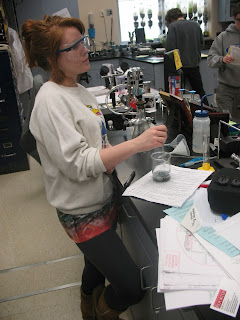SINGLE REPLACEMENT
There was one single replacement reaction that took place in this lab during step 7, demonstrated by the equation:
Zn + CuSO4 -> ZnSO4 + Cu
The driving force of this reaction was the transfer of electrons, through different levels of acitivity seires in the metals present. The copper sulfate solution that we added the zinc to had a higher acivity level than the copper; therefore, the copper was replaced by the zinc in the bond.
DOUBLE REPLACEMENT
There were also two double replacement reactions that occured in our lab. In step 5, the reaction
Cu(NO3)2 + 2NaOH -> Cu(OH)2 + 2NaNO3
In both reactions, the driving force is the formation of a solid, which in this case is called a precipatate. In these cases, one precipatate was formed when two liquids where put together. In step 5, the precipitate that was formed was the cupric phosphate, because neither the copper, nor the phosphate dissolves in water. However, the sodium chloride remained in its aqueos state, because both elements are soluble. In step 2, nearly the same scenario applies. The product copper hydroxide was formed because neither the hydroxide nor the copper was soluble, while the very soluble nitrate and sodium ions remained dissolved in the solution.
In both reactions, the driving force is the formation of a solid, which in this case is called a precipatate. In these cases, one precipatate was formed when two liquids where put together. In step 5, the precipitate that was formed was the cupric phosphate, because neither the copper, nor the phosphate dissolves in water. However, the sodium chloride remained in its aqueos state, because both elements are soluble. In step 2, nearly the same scenario applies. The product copper hydroxide was formed because neither the hydroxide nor the copper was soluble, while the very soluble nitrate and sodium ions remained dissolved in the solution.
























